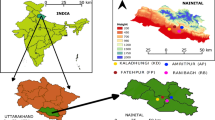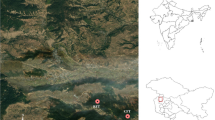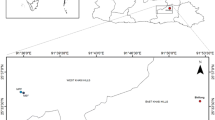Abstract
Aboveground biomass and carbon stock in the largest sacred grove of Manipur was estimated for trees with diameter >10 cm at 1.37 m height. The aboveground biomass, carbon stock, tree density and basal area of the sacred grove ranged from 962.94 to 1130.79 Mg ha−1, 481.47 to 565.40 Mg ha−1 C, 1240 to 1320 stem ha−1 and 79.43 to 90.64 m2 ha−1, respectively. Trees in diameter class of 30–40 cm contributed the highest proportion of aboveground biomass (22.50–33.73%). The aboveground biomass and carbon stock in research area were higher than reported for many tropical and temperate forests, suggesting a role of spiritual forest conservation for carbon sink management.

(Source: ICAR, Imphal)

Similar content being viewed by others
References
Baishya R, Barik SK, Upadhaya K (2009) Distribution pattern of aboveground biomass in natural and plantation forests of humid tropics in northeast India. Trop Ecol 50:295–304
Binkley CS, Apps MJ, Dixon RK, Kauppi PE, Nilsson LO (1997) Sequestering carbon in natural forests. Crit Rev Environ Sci Technol 27(Special):S23–S45
Borah N, Nath AJ, Das AK (2013) Aboveground biomass and carbon stocks of tree species in tropical forests of Cachar district, Assam North East India. Int J Ecol Environ Sci 39(2):97–106
Borah M, Das D, Kalita J, Prasanna H, Borua D, Phukan B, Neog B (2015) Tree species composition, biomass and carbon stocks in two tropical forest of Assam. Biomass Bioenergy 78:25–35
Brown S (1997) Estimating biomass and biomass change of tropical forests: a primer. FAO forestry paper—134. A Forest Resource Assessment Publication, Rome
Brown S, Gillespie AJR, Lugo AE (1989) Biomass estimation methods for tropical forests with application to forest inventory data. For Sci 35:881–902
Brown JH, Gillooly JH, Allen AP, Savage VM, West GB (2004) Toward a metabolic theory of ecology. Ecology 85:1771–1789
Chambers JQ, Santos JD, Ribeiro RJ, Higuchi N (2001) Tree damage, allometric relationships, and above-ground net primary production in central Amazon forest. For Ecol Manag 152:73–84
Chave J, Reira B, Dubois MA (2001) Estimation of biomass in a neo-tropical forest of French Guiana: spatial and temporal variability. J Trop Ecol 17:79–96
Edwards PJ, Grub PJ (1977) Studies of mineral cycling in a montane rainforest in New Guinea. 1. The distribution of organic matter in the vegetation and soil. J Ecol 65:943–969
Gibbs KG, Brown S, Niles JO, Foley JA (2007) Monitoring and estimating tropical forest carbon stocks: making REDD a reality. Environ Res Lett 2(4):1–13
He B, Miao L, Cui X, Wu Z (2015) Carbon sequestration from China’s afforestation projects. Environ Earth Sci 74(7):5491–5499
Kandari LS, Bisht VK, Bhardwaj M, Thakur AK (2014) Conservation and management of sacred groves, myths and beliefs of tribal communities: a case study from north-India. Environ Syst Res 3:16
Khumbongmayum AD, Khan ML, Tripathi RS (2004) Sacred groves of Manipur: ideal centres for biodiversity conservation. Curr Sci 87(4):430–433
Klinge H, Herrera R (1978) Biomass studies in Amazon Caatinga forest in Southern Venezuela. 1. Standing crop of composite root mass in related stand. Trop Ecol 19:93–110
Lebbie AR, Freudenberger MS (1996) Sacred groves in Africa: forest patches in transition. Forest patches in tropical landscapes. Island Press, Washington, DC, pp 300–324
Malhotra KC, Gokhale Y, Chatterjee S, Srivastava S (2007) Sacred groves in India. Aryan Books International, New Delhi
Midgley GF, Bond WJ, Kapos VK, Ravilious C, Scharlemann JPW, Woodward FI (2010) Terrestrial carbon stocks and biodiversity: key knowledge gaps and some policy implications. Curr Opin Environ Sustain 2:264–270
Montagnini F, Nair P (2004) Carbon sequestration: an underexploited environmental benefit of agroforestry systems. Agrofor Syst 61:281–295
Nath AJ, Lal R, Das AK (2015) Grains for ecosystem carbon management in North East India. Curr Sci 109:1187–1189
Ogawa H, Yoda K, Ogino K, Kira T (1965) Comparative ecological studies on three main types of forest vegetation in Thailand. II. Plant biomas. Nat Life Southeast Asia 4:49–80
Ormsby AA (2011) The impacts of global and national policy on the management and conservation of sacred groves of India. Hum Ecol 39:783–793
Ormsby AA (2012) Cultural and conservation values of sacred forest in Ghana. In: Pungetti G, Oviedo G, Hooke D (eds) Sacred species and sites: advances in biocultural conservation. Cambridge University Press, Cambridge
Pala NA, Negi AK, Gokhale Y, Aziem S, Vikrant KK, Todaria NP (2013) Carbon stock estimation for tree species of SemMukhem sacred forest in Garhwal Himalaya, India. J For Res 24(3):457–460
Pan YD, Birdsey RA, Fang JY et al (2011) A large and persistent carbon sink in the world’s forests. Science 333(6045):988–993
Parratt SN (1980) Religion of Manipur. Firma Klmpvt, Calcutta
Ravindranath NH, Somashekhar BS, Gadgil M (1997) Carbon flow in Indian forests. Clim Change 35:297–320
Segura M, Kanninen M (2005) Allometric models for tree volume and total aboveground biomass in a tropical humid forest in Costa Rica. Biotropica 37(1):2–8
Singh JS, Singh SP (1992) Forest of Himalaya: structure, functioning and impact of man. GyanodayaPrakashan, Nainital
UNFCCC (1997) Kyoto protocol to the United Nations framework convention on climate change. http://unfccc.int/resource/docs/convkp/kpeng
Van der Werf GR, Morton DC, Defries RS, Oliver JG, Kasibhatta PS, Jackson RB, Collatz GJ, Randerson J (2009) CO2 emissions from forest loss. Nat Geosci 2:737–738
Yadava PS (2010) Soil and vegetation carbon pool and sequestration in the forest ecosystems of Manipur, NE India. In: Qasim SZ, Goel M (eds) CO2 sequestration technologies for clean energy. Daya publication house, New Delhi, pp 163–170
Acknowledgements
This study was funded by Department of Science and Technology (DST), New Delhi India. We express our sincere gratitude to DST, New Delhi India. We gratefully acknowledge the President of the Phayeng Forest Committee and local people of Phayeng, Manipu, Northeast India for their cooperation during our fieldwork.
Author information
Authors and Affiliations
Corresponding author
Additional information
Project funding: This study was funded by Department of Science and Technology (DST), New Delhi India.
The online version is available at http://www.springerlink.com
Corresponding editor: Yu Lei.
Rights and permissions
About this article
Cite this article
Waikhom, A.C., Nath, A.J. & Yadava, P.S. Aboveground biomass and carbon stock in the largest sacred grove of Manipur, Northeast India. J. For. Res. 29, 425–428 (2018). https://doi.org/10.1007/s11676-017-0439-y
Received:
Accepted:
Published:
Issue Date:
DOI: https://doi.org/10.1007/s11676-017-0439-y




